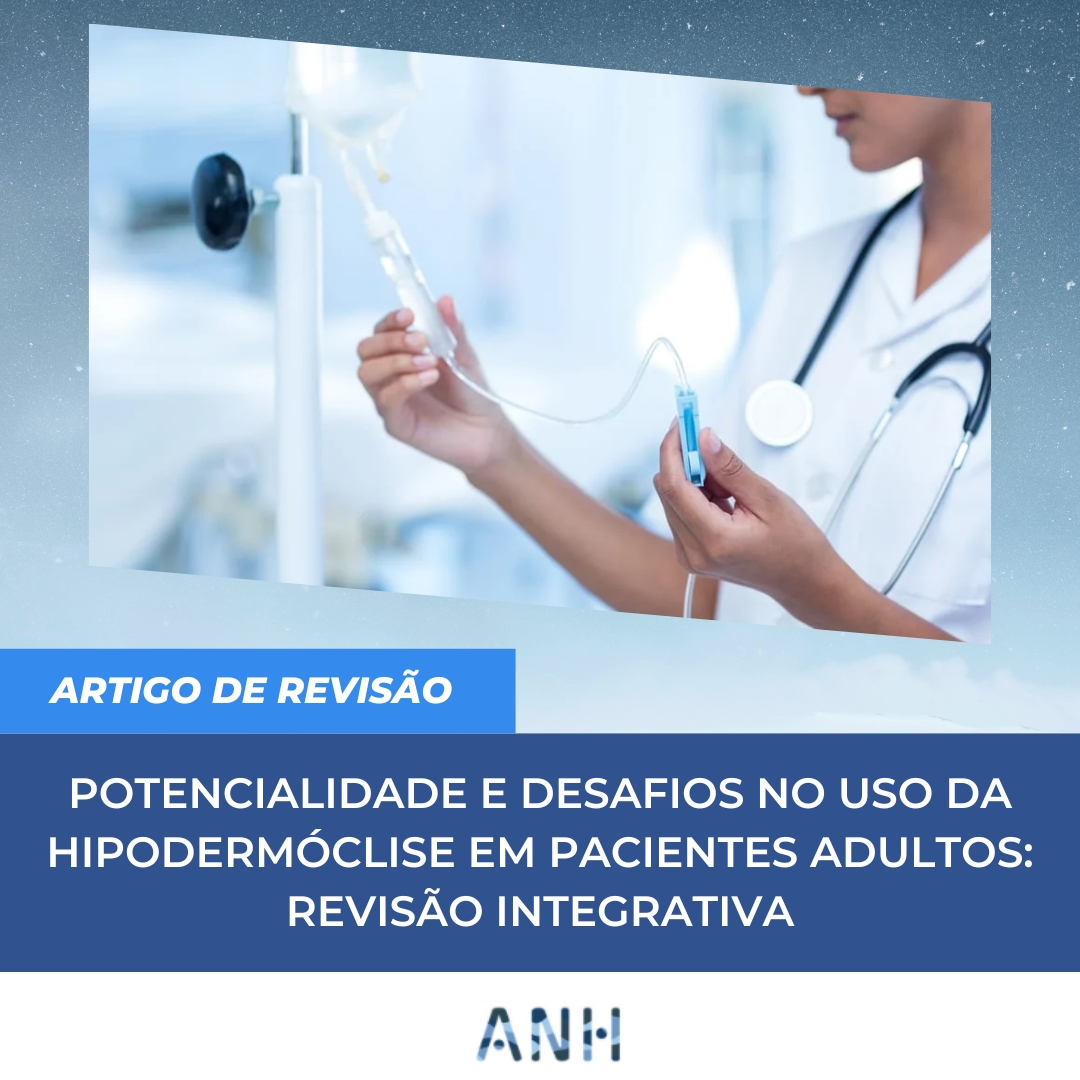Potential and challenges in using hypodermoclysis in adult patients: an integrative review
Potential and challenges in using hypodermoclysis in adult patients
DOI:
https://doi.org/10.5433/anh.2023v5.id45061Keywords:
Hypodermoclysis, Nursing, Palliative Care, Infusions, SubcutaneousAbstract
Objective: to identify national and international scientific evidence about the potential and challenges of hypodermoclysis in adult patients. Method: an integrative literature review, carried out in April 2019, without time frame, using the MEDLINE, CINAHL, Scopus and Embase databases, resulting in a final sample of seven international articles. Results: from the synthesis of evidence, potentialities emerged: feasibility of the technique, possibility of treating dehydration in older adults, use in confused patients, with difficult venous access and at home, low rate of complications, less demand for team care time. The challenges highlighted were: patient acceptance, disease stage, characteristics of administered fluids, teaching the technique at graduation, training of nursing professionals and adoption of clinical protocols. Conclusion: despite the potentiality, there are challenges to be overcome that point to the need for training in using hypodermoclysis, both for professionals and for students in training, which could positively impact hypodermoclysis compliance.
Downloads
References
2. Arinzon Z, Feldman J, Fidelman Z, Gepstein R, Berner YN. Hypodermoclisis (subcutaneous infusion) effective mode of treatment of dehydration in long-term care patients. Arch. gerontol. geriatr. 2004 Mar-Apr; 38(2):167-73. DOI: 10.1016/j.archger.2003.09.003.
3. Remington R, Hultman T. Hipodermoclysis to treat dehydration: A review of the evidence. J. am. geriatr. soc. 2007 Oct; 55(12):2051-5. DOI: 10.1111/j.1532-5415.2007.01437.x.
4. Pontalti G, Rodrigues ESA, Firmino F, Fábris M, Stein MR, Longaray VK. Subcutaneous route: second option in palliative care. Rev. HCPA & Fac. Med. Univ. Fed. Rio Gd. do Sul. 2012; 32(2):199-207. Disponível em: https://pesquisa.bvsalud.org/portal/resource/pt/biblio-834416.
5. Sasson M, Shvartzman P. Hypodermoclysis: An alternative infusion technique. Am. fam. physician. 2001 Nov; 64(9):1575-9. Disponível em: https://www.aafp.org/afp/2001/1101/p1575.html.
6. Conselho Regional de Enfermagem de São Paulo (COREN). Parecer COREN-SP 031/2014 - CT de 4 de julho de 2014. São Paulo; 2014.
7. Caccialanza R, Constans T, Cotogni P, Zaloga GP, Pontes-Arruda A. Subcutaneous infusion of fluids for hydration or nutrition: a review. JPEN J. parenter. enteral nutr. 2016 Feb; 42(2):296-307. DOI: 10.1177/0148607116676593.
8. Vidal M, Hui D, Williams J, Bruera E. A prospective study of hypodermoclysis performed by caregivers in the home setting. J. pain symptom manage. 2016 Oct; 52(4):570-574. DOI: 10.1016/j.jpainsymman.2016.04.009.
9. Duems-Noriega O, Ariño-Blasco S. Subcutaneous fluid and drug delivery: safe, efï¬cient and inexpensive. Rev. clin. gerontol. 2015 May; 25(2):117-146. DOI: https://doi.org/10.1017/S095925981500012X.
10. Nunes PMSA, Souza RCS. Adverse effects of hypodermoclysis in adult patients: an integrative review. REME rev. min. enferm. 2016; 20: e951. DOI: 10.5935/1415-2762.20160020.
11. Bruno VG. Hypodermoclysis: a literature review to assist in clinical practice. Einstein (São Paulo).. 2015; 13(1):122-8. DOI: 10.1590/S1679-45082015RW2572.
12. Zironde ES, Marzenini NL, Soler VP. Hypodermoclysis: rediscovery of subcutaneously in the treatment of vulnerable. CuidArte, Enferm. 2014 Jan-Jun; 8(1): 55-61. Disponível em: http://fundacaopadrealbino.org.br/facfipa/ner/pdf/cuidarte_enfermagem_v8_n1_jan_jun_2014.pdf.
13. Turner T, Cassano AM. Subcutaneous dextrose for rehydration of elderly patients: an evidence-based review. BMC geriatr. (Online). 2004 Apr; 4:2. DOI: 10.1186/1471-2318-4-2.
14. Fainsinger RL, MacEachern T, Miller MJ, Bruera E, Spachynski K, Kuehn N et al. The use of hypodermoclysis for rehydration in terminally ill cancer patients. J. pain symptom manage. 1994 Jul; 9(5):298-302. DOI: 10.1016/0885-3924(94)90187-2.
15. Conselho Regional de Medicina do Estado de São Paulo. Cuidado Paliativo. São Paulo: CREMESP; 2008. 689 p.
16. Justino ET, Tuoto FS, Kalinke LP, Mantovani MF. Hypodermoclysis in oncology patients receiving palliative care. Cogitare enferm. 2013 Jan-Mar; 18(1):84-9. DOI: http://dx.doi.org/10.5380/ce.v18i1.31307.
17. Khan M, Younger G. Promoting safe administration of subcutaneous infusions. Nurs. stand. 2007 Apr; 21(31):50-6. DOI: 10.7748/ns2007.04.21.31.50.c4545.
18. Mendes KDS, Silveira RCCP, Galvão CM. Integrative literature review: a research method to incorporate evidence in health care and nursing. Texto & contexto enferm. 2008 Oct-Dec; 17(4):758-64. DOI: https://doi.org/10.1590/S0104-07072008000400018.
19. Santos CMC, Pimenta CAM, Nobre MRC. The PICO strategy for the research question construction and evidence search. Rev. latinoam. enferm. (Online). 2007 Jun; 15(3):508-11. DOI: 10.1590/S0104-11692007000300023.
20. Ursi ES, Galvão CM. Perioperative prevention of skin injury: an integrative literature review. Rev. latinoam. enferm. (Online). 2006 Jan-Feb; 14(1):124-31. DOI: https://doi.org/10.1590/S0104-11692006000100017.
21. Melnyk BM, Finout-Overholt E. Evidence-based practice in nursing & healthcare: a guide to best practice. 3a ed. USA: Wolters Klumer; 2014. 656 p.
22. Hussain NA, Warshaw G. Utility of clysis for hydration in nursing home residents. J. am. geriatr. soc. 1996 Jul; 44(8):969-73. DOI: 10.1111/j.1532-5415.1996.tb01870.x.
23. Worobec F, Brown MK. Hypodermoclysis therapy: in a chronic care hospital setting. J. gerontol. nurs. 1997 Jun; 23(6):23-8. DOI: 10.3928/0098-9134-19970601-10.
24. Dasgupta M, Binns MA, Rochon PA. Subcutaneous fluid infusion in a long-term care setting. J. am. geriatr. soc. 2000 Jul; 48(7):795-9. DOI: https://doi.org/10.1111/j.1532-5415.2000.tb04755.x.
25. Slesak G, Schnürle JW, Kinzel E, Jakob J, Dietz K. Comparison of Subcutaneous and Intravenous Rehydration in Geriatric Patients: A Randomized Trial. J. am. geriatr. soc. 2003 Feb; 51(2):155-60. DOI: 10.1046/j.1532-5415.2003.51052.x
26. Cabañero-Martínez MJ, Velasco-Álvarez ML, Ramos-Pichardo JD, Miralles MLR, Valladares MP, Cabrero-García J. Perceptions of health professionals on subcutaneous hydration in palliative care: A qualitative study. Palliat. med. 2016 Jun; 30(6):549 -57. DOI: 10.1177/0269216315616763.
27. Esmeray G, Şenturan L, Döventaş A. A study on efficacy of hydration administered by subcutaneous infusion in geriatric patients. Turkish Journal of Geriatrics. 2018; 21(3):438-45. DOI: 10.31086/tjgeri.2018344059.
28. Scales K. Use of hypodermoclysis to manage dehydration. Nurs. older people. 2011 Jun; 23(5):16-22. DOI: 10.7748/nop2011.06.23.5.16.c8528.
29. Brasil. Ministério da Saúde. Instituto Nacional de Câncer. Terapia subcutânea no câncer avançado. Instituto Nacional de Câncer - Rio de Janeiro: INCA, 2009. 32p.
30. Martins SB, Cordeiro FR, Zillmer JCV, Arrieira ICO, Oliveira AT, Santos C. Percepciones de los cuidadores familiares sobre el uso de la hipodermoclisis en el hogar. Enfermería Actual em Costa Rica. 2020; 38. Disponível em: https://www.scielo.sa.cr/pdf/enfermeria/n38/1409-4568-enfermeria-38-103.pdf.
31. Rodrigues FS, Pedra MC, Santos JLG, Rumor PCF, Girondi JBR, Oliveira MC. Continuing education on hypodermoclysis with the nursing team of a hospital surgical unit. Rev. enferm. UFPE on line. 2016 Apr; 10(3):1562-70. DOI: 10.5205/reuol.7057-60979-3-SM-1.1003sup201625.
32. Silva PRC, Santos EB. Cuidados paliativos - hipodermóclise uma técnica do passado com futuro: revisão da literatura. Rev. cientif. enferm. 2018; 8(22): 53-63. Disponível em: https://www.recien.com.br/index.php/Recien/article/view/248/pdf.
33. Takaki CYI, Klein GFS. Hipodermoclysis: the knowledge of nurse on inpatient unit. Conscientiae saúde (Impr.). 2010; 9(3):486-96.
34. Lima MLR. Conhecimento da equipe de sauÌde de um hospital universitaÌrio sobre hipodermoÌclise [monografia]. Goiânia: Universidade Federal de Goiás, Faculdade de Enfermagem; 2018.
35. Gabriel J. The use of subcutaneous infusion in medication administration. Br. j. nurs. 2013 Sep; 22(14):S6-S10. DOI: 10.12968/bjon.2013.22.Sup9.S6.
36. Zitelli PMY, Gozzi MM, Trovo MM. Hypodermoclysis in oncology patients in palliative care. Revista Saúde online [Internet]. 2014 [cited 2020 Jun 23]; 8(1-2):37-42. Available from: http://revistas.ung.br/index.php/saude/article/view/1575/1532
37. Quaglio RC, Varallo FR, Lima NKC, Junqueira AF, Ianhez Júnior E, Matumoto S et al. Medicines subject to hypodermoclysis infusion. Medicina (Ribeirão Preto). 2018 Jan-Mar; 51(1):55-68. DOI: 10.11606/issn.2176-7262.v51i1p55-68.
38. Dickman A, Bickerstaff M, Jackson R, Schneider J, Mason S, Ellershaw J. Identification of drug combinations administered by continuous subcutaneous infusion that require analysis for compatibility and stability. BMC palliat. care. 2017 Mar; 16:22. DOI: 10.1186/s12904-017-0195-y.
39. Pimenta CAM, Lopes CT, Amorim AF, Nishi FA, Shimoda GT, Jensen R. Guia para construção de protocolos assistenciais de enfermagem. São Paulo: COREN-SP. 2015. 50p.
40. Brasil. Ministério da Saúde. Programa Nacional de Segurança do Paciente. Portaria nº 529, de 02 de abril de 2013. Diário Oficial da União. Seção 1,62:43. 2 abril 2013.
41. Freitas IM, Oliveira HÁ, Braga PG, Santos POO, Alcântara CO, Espíndola TC et al. Use of hypodermoclisis analysis in cancer hospitalized patients in palliative care in two public hospitals in Belo Horizonte. Rev. méd. Minas Gerais. 2018; 28 (Supl 5): e-S280516. DOI: 10.5935/2238-3182.20180128.

Downloads
Published
How to Cite
Issue
Section
License
Copyright (c) 2023 Advances in Nursing and Health

This work is licensed under a Creative Commons Attribution 4.0 International License.
All or the content of the newspaper is licensed under a Creative Commons Attribution License, of the CC-BY attribution type.
Authors retain the copyright, and authors are asked to indicate first publication in this journal in the event of republication. Articles published in Advances in Nursing and Health are licensed under the Creative Commons Attribution 4.0 International License, which ensures Open Access. This license allows any user to read, download, copy, and share the content, as long as it is properly cited. It also permits the reuse of the material, including its distribution, adaptation, and creation of derivative works in any format or medium, provided appropriate credit is given, a link to the license is provided, and any changes made are indicated. In addition, the license allows commercial use of the content.


















